Improved Resistive and Synaptic Characteristics in Neuromorphic Systems Achieved Using the Double-Forming Process
Abstract
:1. Introduction
2. Experimental Section
3. Results and Discussion
4. Conclusions
Author Contributions
Funding
Data Availability Statement
Conflicts of Interest
References
- Avci, U.E.; Morris, D.H.; Young, I.A. Tunnel field-effect transistors: Prospects and challenges. IEEE J. Electron Device Soc. 2015, 3, 88–95. [Google Scholar] [CrossRef]
- Lonescu, A.M.; Riel, H. Tunnel field-effect transistors as energy-efficient electronic switches. Nature 2011, 479, 329–337. [Google Scholar] [CrossRef] [PubMed]
- Jeong, H.; Shi, L. Memristor devices for neural networks. J. Phys. D Appl. Phys. 2018, 52, 023003. [Google Scholar] [CrossRef]
- Pan, F.; Chen, C.; Wang, Z.; Yang, Y.; Yang, J.; Zeng, F. Nonvolatile resistive switching memories-characteristics, mechanisms and challenges. Prog. Nat. Sci. 2010, 20, 1–15. [Google Scholar] [CrossRef]
- Ou, Q.F.; Xiong, B.S.; Yu, L.; Wen, J.; Wang, L.; Tong, Y. In-Memory Logic Operations and Neuromorphic Computing in Non-Volatile Random Access Memory. Materials 2020, 13, 3532. [Google Scholar] [CrossRef] [PubMed]
- Tehrani, S.; Slaugther, J.M.; Chen, E.; Durlam, M.; Shi, J.; DeHerren, M. Progress and outlook for MRAM technology. IEEE Trans. Magn. 1999, 35, 2814–2819. [Google Scholar] [CrossRef]
- Sarwat, S.G. Materials science and engineering of phase change random access memory. Mater. Sci. Technol. 2017, 33, 1890–1906. [Google Scholar] [CrossRef]
- Takashima, D.; Kunishima, I. High-density chain ferroelectric random access memory (chain FRAM). IEEE J. Solid-State Circuit 1998, 33, 787–792. [Google Scholar] [CrossRef]
- Wang, Z.; Wu, H.; Burr, G.W.; Hwang, C.S.; Wang, K.L.; Xia, Q.; Yang, J.J. Resistive switching materials for information processing. Nat. Rev. Mater. 2020, 5, 173–195. [Google Scholar] [CrossRef]
- Marković, D.; Mizrahi, A.; Querlioz, D.; Grollier, J. Physics for neuromorphic computing. Nat. Rev. Phys. 2020, 2, 499–510. [Google Scholar] [CrossRef]
- Kim, K.M.; Jeong, D.S.; Hwang, C.S. Nanofilamentary resistive switching in binary oxide system; a review on the present status and outlook. Nanotechnology 2011, 22, 254002. [Google Scholar] [CrossRef] [PubMed]
- Li, Y.; Long, S.; Liu, Q.; Lv, H.; Liu, M. Resistive switching performance improvement via modulating nanoscale conductive filament, involving the application of two-dimensional layered materials. Small 2017, 13, 1604306. [Google Scholar] [CrossRef] [PubMed]
- Zahoor, F.; Zulkifli, T.Z.A.; Khanday, F.A. Resistive Random Access Memory (RRAM): An Overview of Materials, Switching Mechanism, Performance, Multilevel Cell (mlc) Storage, Modeling, and Applications. Nanoscale Res. Lett. 2020, 15, 90. [Google Scholar] [CrossRef] [PubMed]
- Yang, Y.; Lu, W.D. Progress in the characterizations and understanding of conducting filaments in resistive switching devices. IEEE Tans. Nanotechnol. 2016, 15, 465–472. [Google Scholar] [CrossRef]
- Lee, D.; Choi, H.; Sim, H.; Choi, D.; Hwang, H.; Lee, M.J.; Seo, S.A.; Yoo, I.K. Resistance switching of the nonstoichiometric zirconium oxide for nonvolatile memory applications. IEEE Electron Device Lett. 2005, 26, 719–721. [Google Scholar]
- Ju, D.; Kim, J.; Kim, S. Highly uniform resistive switching characteristics of Ti/TaOx/ITO memristor devices for neuromorphic system. J. Alloys Compd. 2023, 961, 170920. [Google Scholar] [CrossRef]
- Shen, Z.; Qi, Y.; Mitrovic, I.Z.; Zhao, C.; Hall, S.; Yang, L.; Luo, T.; Huang, Y.; Zhao, C. Effect of Annealing Temperature for Ni/AlOx/Pt RRAM Devices Fabricated with Solution-Based Dielectric. Micromachines 2019, 10, 446. [Google Scholar] [CrossRef]
- Cho, H.; Kim, S. Short-Term Memory Dynamics of TiN/Ti/TiO2/SiOx/Si Resistive Random Access Memory. Nanomaterials 2020, 10, 1821. [Google Scholar] [CrossRef]
- Ryu, H.; Kim, S. Effects of Oxygen Precursor on Resistive Switching Properties of CMOS Compatible HfO2-Based RRAM. Metals 2021, 11, 1350. [Google Scholar] [CrossRef]
- Smith, R.C.; Ma, T.; Hoilien, N.; Tsung, L.Y.; Bevan, M.J.; Colombo, L.; Roberts, J.; Campbell, S.A.; Gladfelter, W.L. Chemical vapour deposition of the oxides of titanium, zirconium and hafnium for use as high-k materials in microelectronic devices. A carbon-free precursor for the synthesis of hafnium dioxide. Adv. Mater. Opt. Electron. 2000, 10, 105–114. [Google Scholar] [CrossRef]
- Lin, C.Y.; Wu, C.Y.; Wu, C.Y.; Lee, T.C.; Yang, F.L.; Hu, C.; Tseng, T.Y. Effect of Top Electrode Material on Resistive Switching Properties of ZrO2 Film Memory Devices. IEEE Electron Device Lett. 2007, 28, 366–368. [Google Scholar] [CrossRef]
- Kim, C.; Lee, Y.; Kim, S.; Kang, M.; Kim, S. Diverse synaptic weight adjustment of bio-inspired ZrOx-based memristors for neuromorphic system. Mater. Sci. Semicond. Process. 2023, 157, 107314. [Google Scholar] [CrossRef]
- Huang, C.Y.; Huang, C.Y.; Tsai, T.L.; Lin, C.A.; Tseng, T.Y. Switching mechanism of double forming process phenomenon in ZrOx/HfOy bilayer resistive switching memory structure with large endurance. Appl. Phys. Lett. 2014, 104, 062901. [Google Scholar] [CrossRef]
- Zhang, Y.; Wang, C.; Wu, X. Review of electrical stimulus methods of in situ transmission electron microscope to study resistive random access memory. Nanoscale 2022, 14, 9542. [Google Scholar] [CrossRef] [PubMed]
- Proctor, A.; Sherwood, P.M.A. Data Analysis Techniques in X-ray Photoelectron Spectroscopy. Anal. Chem. 1982, 54, 13–19. [Google Scholar] [CrossRef]
- Strukov, D.B.; Kohlstedt, H. Resistive switching phenomena in thin films: Materials, devices, and applications. MRS Bull. 2012, 37, 108–114. [Google Scholar] [CrossRef]
- Cohen, G.; Afshar, S.; Tapson, J.; Schaik, A.V. EMNIST: Extending MNIST to handwritten letters. In Proceedings of the International Joint Conference on Neural Networks (IJCNN), Anchorage, AK, USA, 14–19 May 2017; pp. 2921–2926. [Google Scholar]
- Milo, V.; Lemini, D.; Chicca, E. Attractor networks and associative memories with STDP learning in RRAM synapses. In Proceedings of the IEEE International Electron Devices Meeting (IEDM), San Francisco, CA, USA, 2–6 December 2017; pp. 11.2.1–11.2.4. [Google Scholar]
- Li, C.; Hsieh, J.H. Experimental Investigation on the Sputtering Process for Tantalum Oxynitride Thin Films. Photonics 2021, 8, 53. [Google Scholar] [CrossRef]
- Matsumoto, R.; Nishizawa, Y.; Kataoka, N.; Tanaka, H.; Yoshikawa, H.; Tanuma, S.; Yoshihara, K. Reproducibility of XPS analysis for film thickness of SiO2/Si by active Shirley method. J. Electron Spectrosc. Relat. Phenom. 2016, 207, 55–59. [Google Scholar] [CrossRef]
- Kundu, S.; Halder, N.N.; Biswas, D.; Banerji, P.; Shripathi, T.; Chakraborty, S. Role of ultra thin pseudomorphic InP layer to improve the high-k dielectric/GaAs interface in realizing metal-oxide-semiconductor capacitor. J. Appl. Phys. 2012, 112, 034514. [Google Scholar] [CrossRef]
- Korkos, S.; Xanthopoulos, N.J.; Botzakaki, M.A.; Drivas, C.; Kennou, S.; Ladas, S.; Travlos, A.; Georga, S.N.; Krontiras, C.A. XPS analysis and electrical conduction mechanisms of atomic layer deposition grown Ta2O5 thin films onto p-Si substrates. J. Vac. Sci. Technol. 2020, 38, 032402. [Google Scholar] [CrossRef]
- Piallat, F.; Beugin, V.; Gassilloud, R.; Dussault, L.; Pelissier, B.; Leroux, C.; Caubet, P.; Vallée, C. Interface and plasma damage analysis of PEALD TaCN deposited on HfO2 for advanced CMOS studied by angle resolved XPS and C–V. Appl. Surf. Sci. 2014, 303, 388–392. [Google Scholar] [CrossRef]
- Zaman, A.; Meletis, E.I. Microstructure and mechanical properties of TaN thin films prepared by reactive magnetron sputtering. Coatings 2017, 7, 209. [Google Scholar] [CrossRef]
- Chia, J.Y.; Lertvanithphol, T.; Chaikeeree, T.; Seawsakul, K.; Thamrongsiripak, N.; Nakajima, H.; Songsiriritthigul, P.; Horprathum, M.; Nuntawong, N. Work function alteration of the porous indium tin oxide nanorods film by electron beam irradiation technique. Radiat. Phys. Chem. 2021, 188, 109664. [Google Scholar] [CrossRef]
- Dong, Y.F.; Wang, S.J.; Feng, Y.P.; Huan, A.C.H. Chemical tuning of band alignments for metal gate/high- oxide interfaces. Phys. Rev. B 2006, 73, 045302. [Google Scholar] [CrossRef]
- Fulton, C.C.; Lucovsky, G.; Nemanich, R.J. Electronic properties of the Zr–ZrO2–SiO2–Si (100) gate stack structure. J. Appl. Phys. 2006, 99, 063708. [Google Scholar] [CrossRef]
- Lahmer, M.A. Electronic structure, work function and band alignment of low Miller-index β-TaON surfaces; a DFT + U study. Comput. Condens. Matter 2023, 36, e00824. [Google Scholar] [CrossRef]
- Zhao, M.; Wu, H.; Gao, B.; Zhang, Q.; Wu, W.; Wang, S.; Xi, Y.; Wu, D.; Deng, N.; Yu, S.; et al. Investigation of statistical retention of filamentary analog RRAM for neuromophic computing. In Proceedings of the IEEE International Electron Devices Meeting (IEDM), San Francisco, CA, USA, 2–6 December 2017; pp. 39.4.1–39.4.4. [Google Scholar]
- Chand, U.; Huang, K.C.; Huang, C.Y.; Tseng, T.Y. Mechanism of Nonlinear Switching in HfO2-Based Crossbar RRAM With Inserting Large Bandgap Tunneling Barrier Layer. IEEE Trans. Electron Devices 2015, 62, 3665–3670. [Google Scholar] [CrossRef]
- Wang, Q.; Itoh, Y.; Tsuruoka, T.; Ohtsuka, S.; Shimizu, T.; Shingubara, S.; Hasegawa, T.; Aono, M. Dynamic moderation of an electric field using a SiO2 switching layer in TaOx -based ReRAM. Phys. Status Solidi-Rapid Res. Lett. 2015, 9, 166–170. [Google Scholar] [CrossRef]
- Tsai, T.L.; Chang, H.Y.; Lou, J.J.; Tseng, T.Y. A high performance transparent resistive switching memory made from ZrO2/AlON bilayer structure. Appl. Phys. Lett. 2016, 108, 153505. [Google Scholar] [CrossRef]
- Simanjuntak, F.M.; Panda, D.; Tsai, T.; Lin, C.; Wei, K.; Tseng, T. Enhanced switching uniformity in AZO/ZnO1−x/ITO transparent resistive memory devices by bipolar double forming. Appl. Phys. Lett. 2015, 107, 033505. [Google Scholar] [CrossRef]
- Woo, J.; Yu, S. Resistive Memory-Based Analog Synapse: The Pursuit for Linear and Symmetric Weight Update. IEEE Nanotechnol. Mag. 2018, 12, 36–44. [Google Scholar] [CrossRef]
- Caporale, N.; Dan, Y. Spike timing–dependent plasticity: A Hebbian learning rule. Annu. Rev. Neurosci. 2008, 31, 25–46. [Google Scholar] [CrossRef] [PubMed]
- Ryu, H.; Choi, J.; Kim, S. Voltage Amplitude-Controlled Synaptic Plasticity from Complementary Resistive Switching in Alloying HfOx with AlOx-Based RRAM. Metals 2020, 10, 1410. [Google Scholar] [CrossRef]
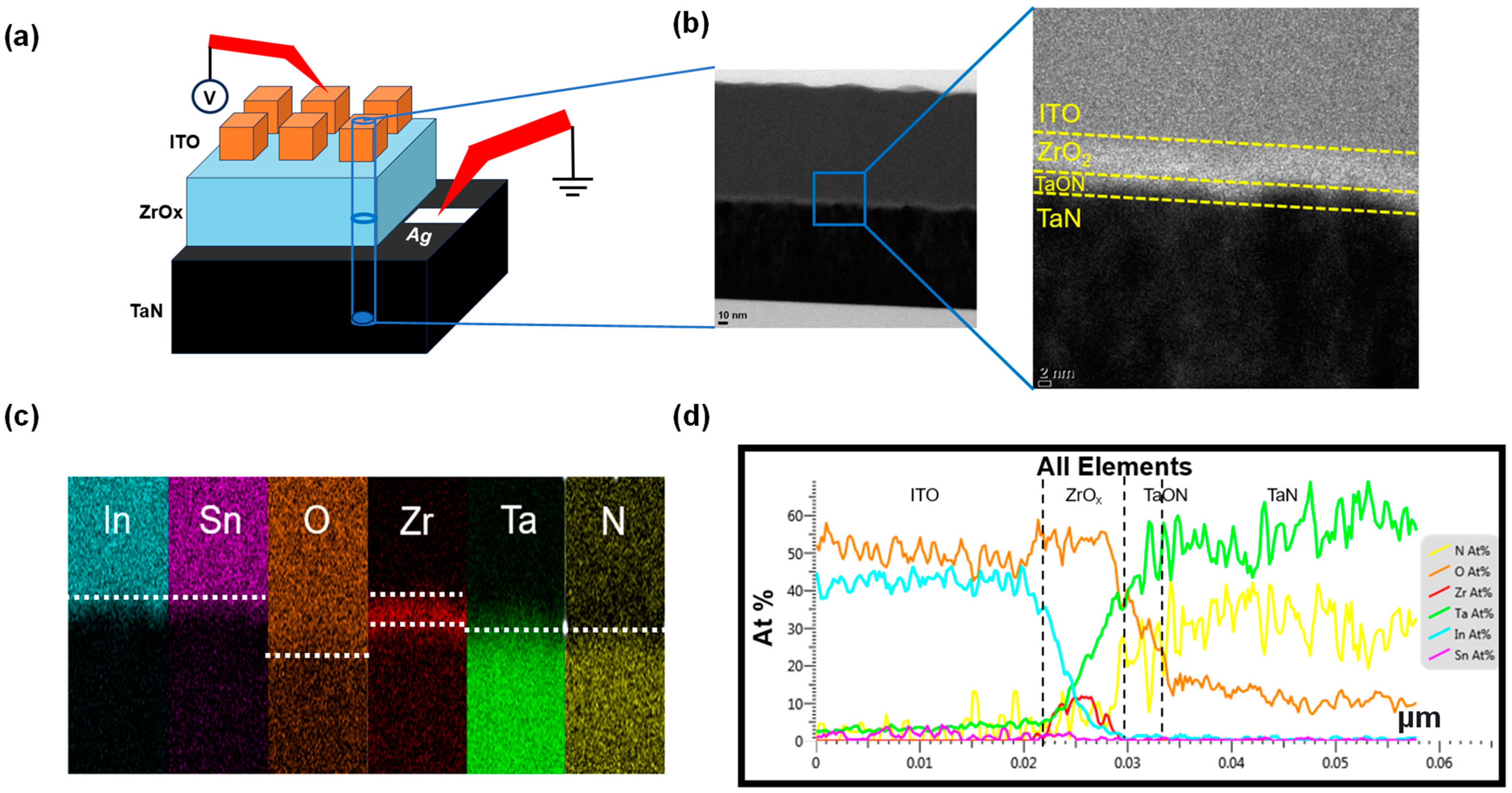
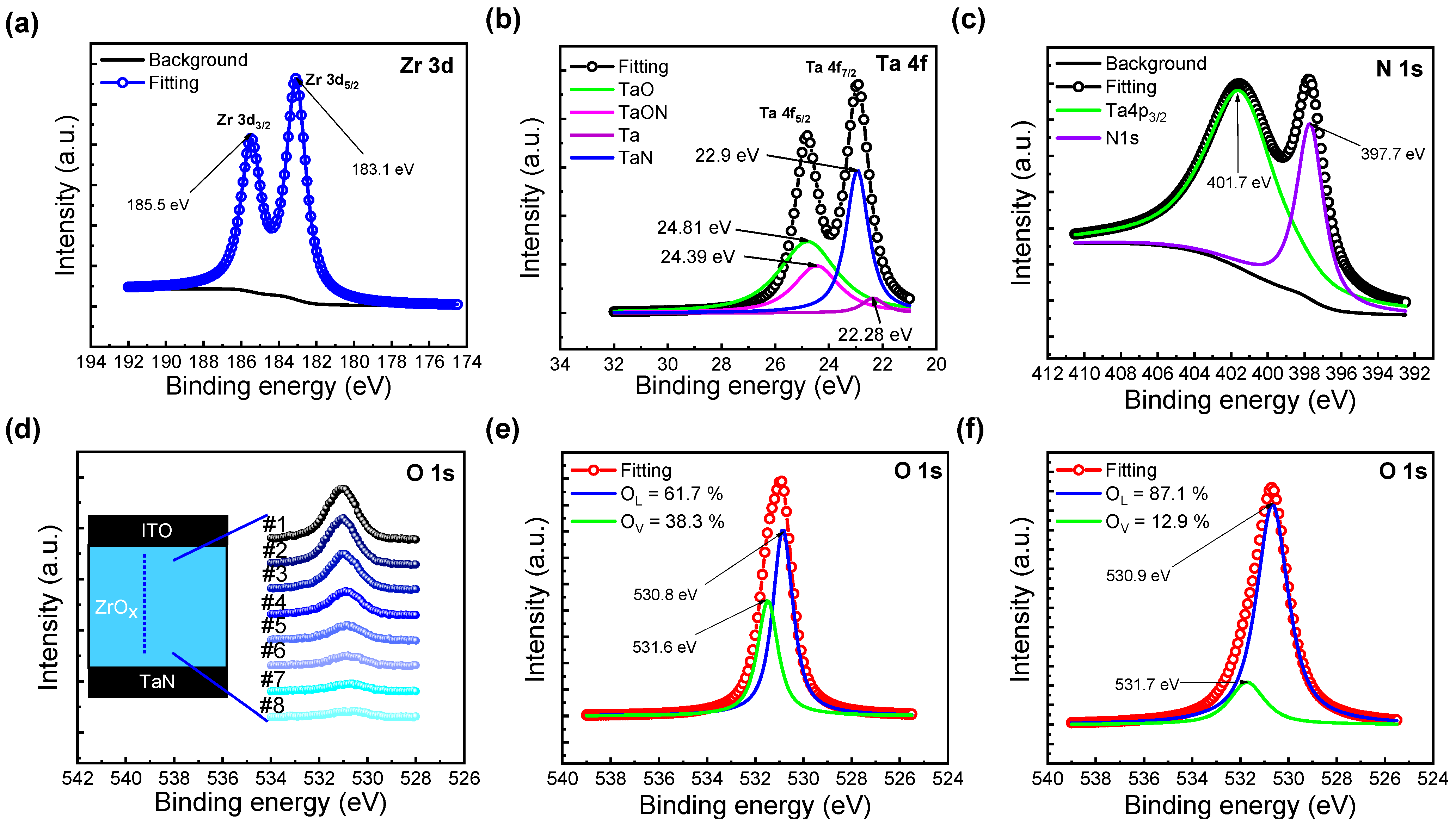
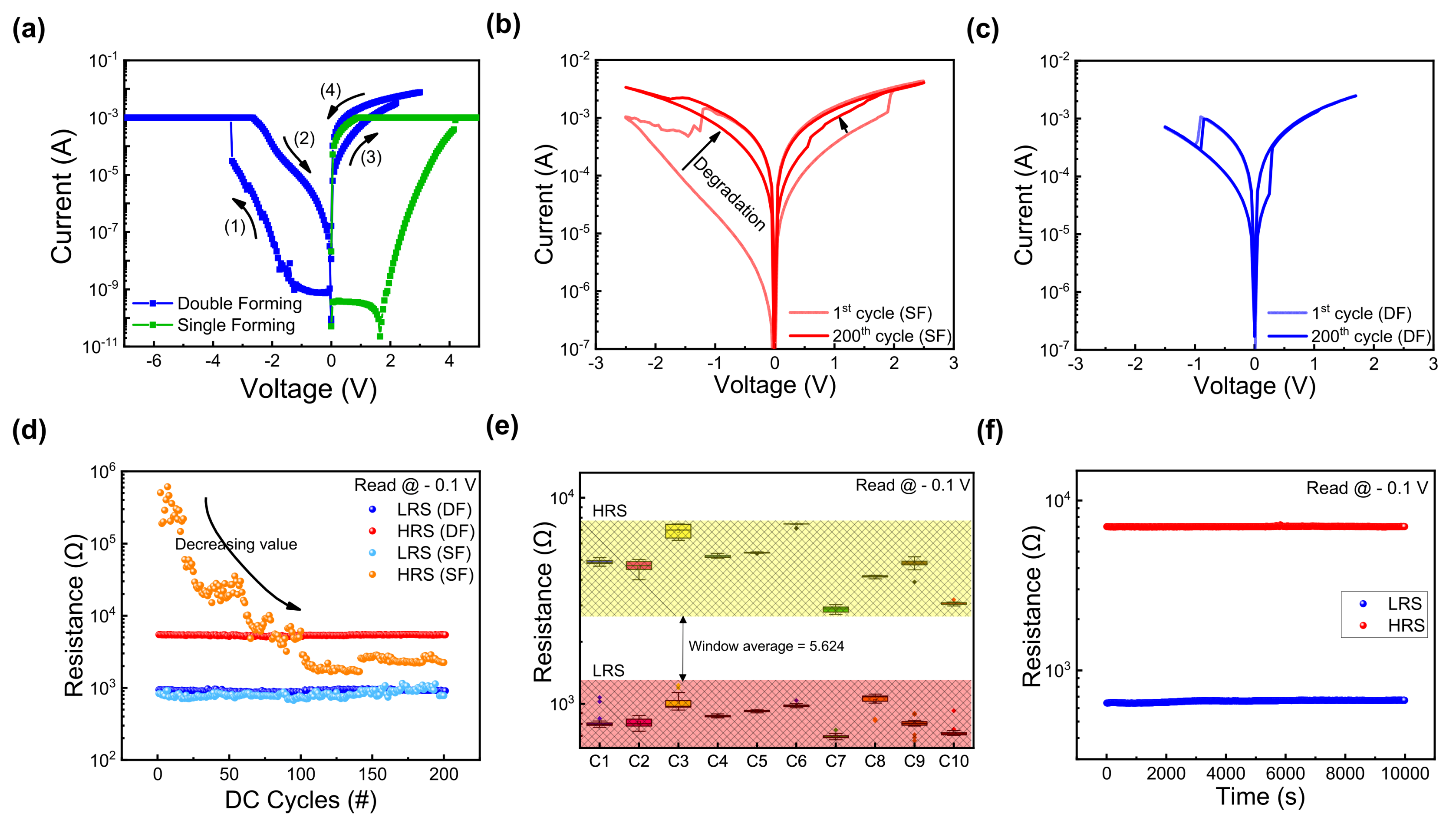

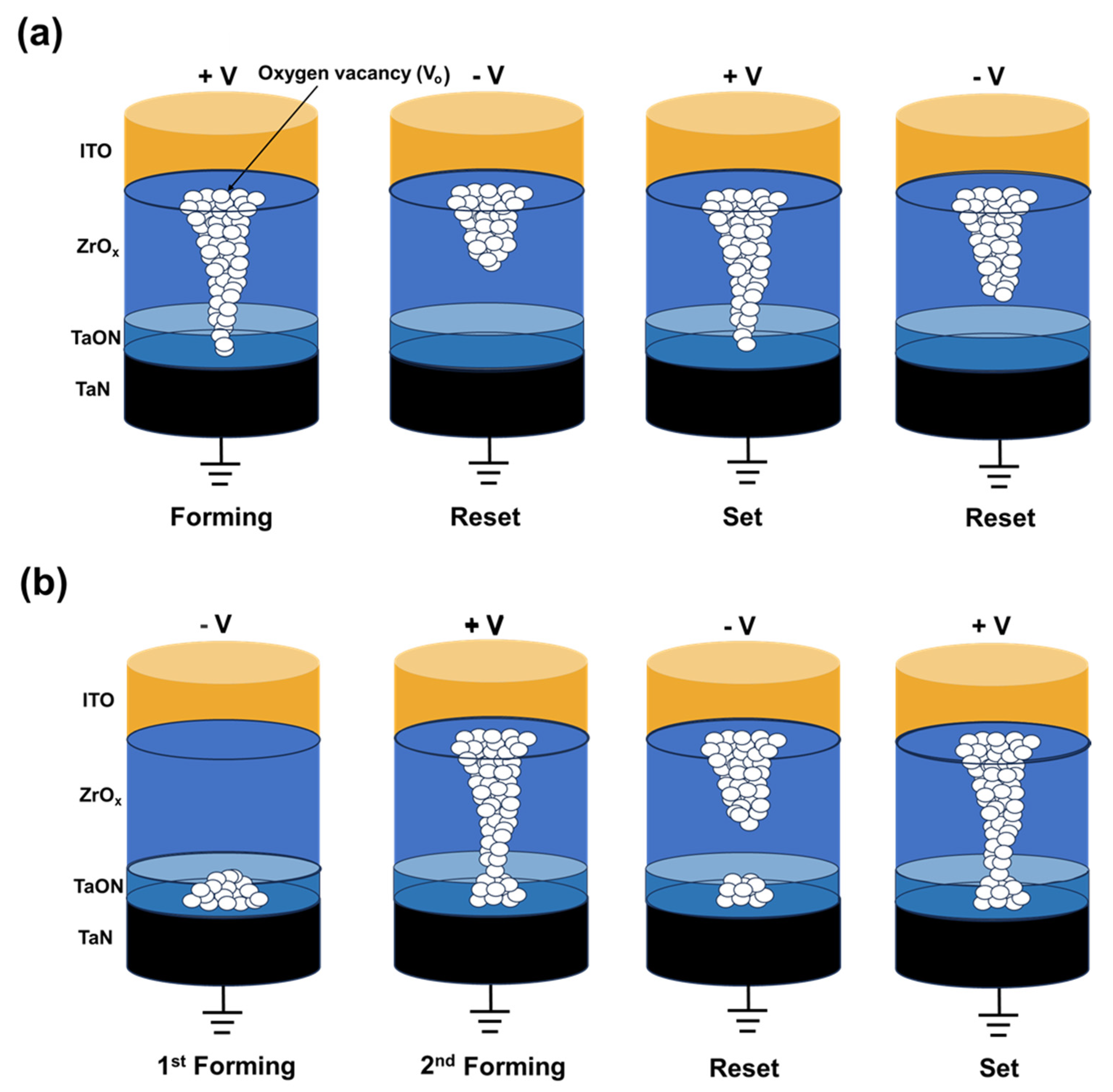
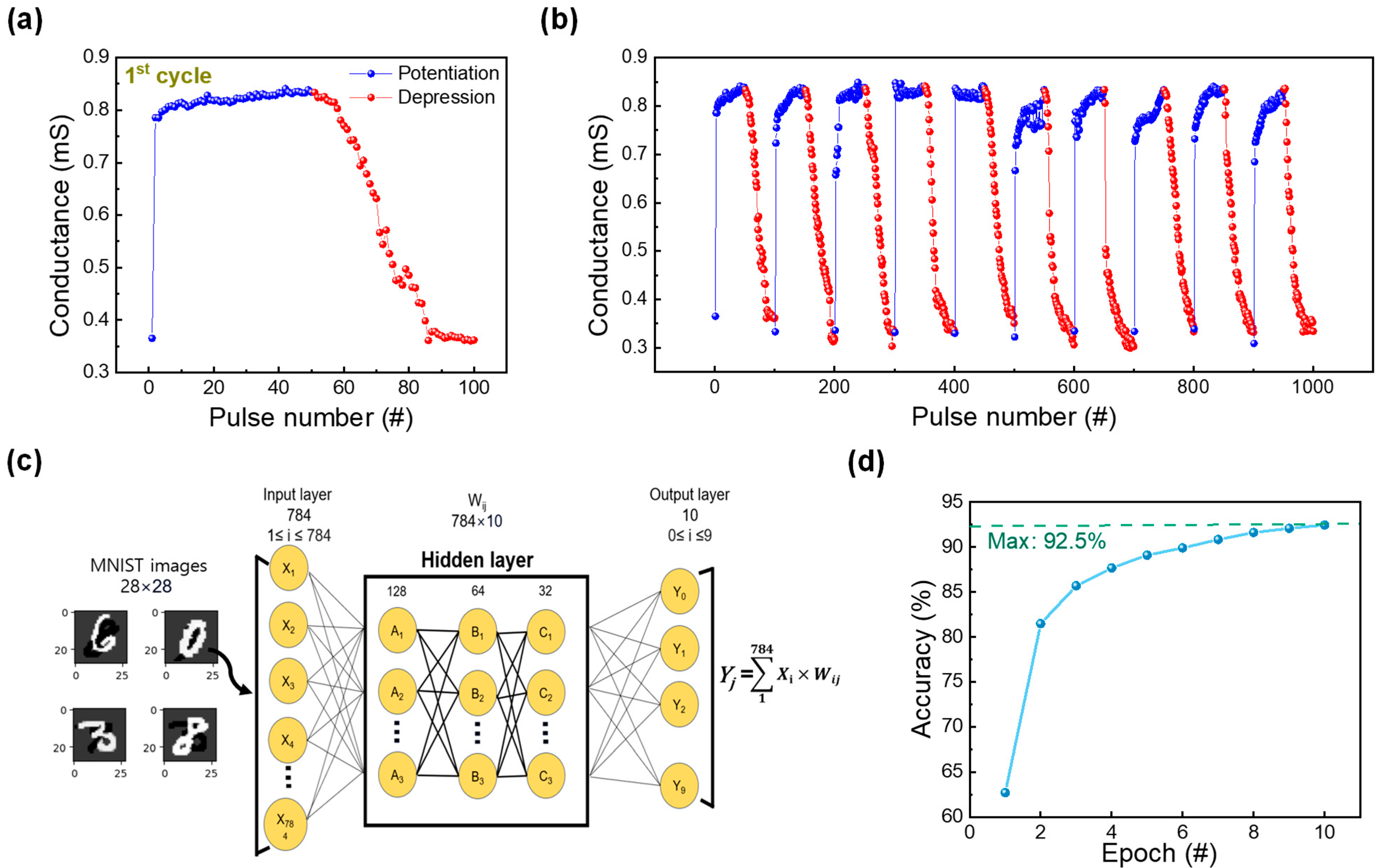

Disclaimer/Publisher’s Note: The statements, opinions and data contained in all publications are solely those of the individual author(s) and contributor(s) and not of MDPI and/or the editor(s). MDPI and/or the editor(s) disclaim responsibility for any injury to people or property resulting from any ideas, methods, instructions or products referred to in the content. |
© 2023 by the authors. Licensee MDPI, Basel, Switzerland. This article is an open access article distributed under the terms and conditions of the Creative Commons Attribution (CC BY) license (https://creativecommons.org/licenses/by/4.0/).
Share and Cite
Kim, M.; Ju, D.; Kang, M.; Kim, S. Improved Resistive and Synaptic Characteristics in Neuromorphic Systems Achieved Using the Double-Forming Process. Nanomaterials 2023, 13, 2859. https://doi.org/10.3390/nano13212859
Kim M, Ju D, Kang M, Kim S. Improved Resistive and Synaptic Characteristics in Neuromorphic Systems Achieved Using the Double-Forming Process. Nanomaterials. 2023; 13(21):2859. https://doi.org/10.3390/nano13212859
Chicago/Turabian StyleKim, Minkang, Dongyeol Ju, Myounggon Kang, and Sungjun Kim. 2023. "Improved Resistive and Synaptic Characteristics in Neuromorphic Systems Achieved Using the Double-Forming Process" Nanomaterials 13, no. 21: 2859. https://doi.org/10.3390/nano13212859
APA StyleKim, M., Ju, D., Kang, M., & Kim, S. (2023). Improved Resistive and Synaptic Characteristics in Neuromorphic Systems Achieved Using the Double-Forming Process. Nanomaterials, 13(21), 2859. https://doi.org/10.3390/nano13212859








